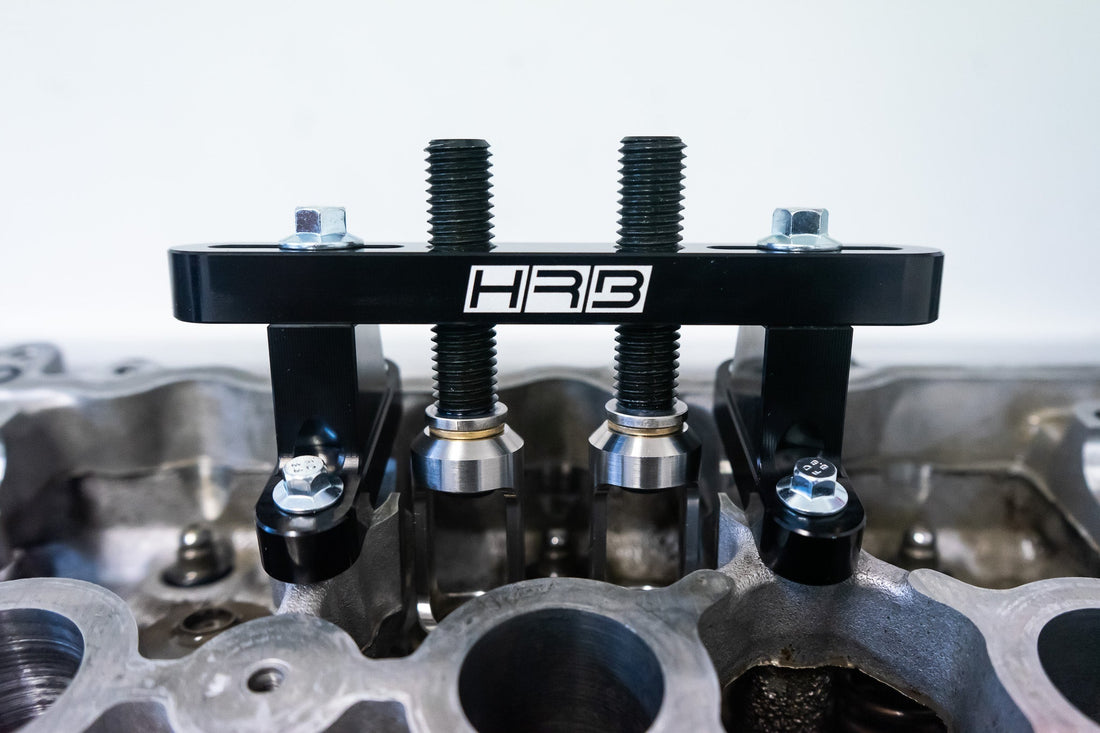
How to Remove Valve Springs Without Removing the Head
Share
Removing valve springs with the head still on the engine sounds like a job for the pros, but it’s actually a practical, repeatable job—if you’ve got the right tools and approach.
Back when I was an apprentice in the local performance engine shop, this kind of task came up regularly. Sometimes it was a cam upgrade, sometimes just a spring refresh, but we often had to find a way to do the job without pulling the head. We had the tools, but they didn’t always fit the engine in the way that you’d like them to. We’d wrestle with generic compressors, even modifying and building tools for the job. Every engine shop has them, the assorted custom tools and adapters box. The process was slow, frustrating, and easy to mess up.
That experience stuck with me. Years later (and how many engines), it led to the development of HRB’s in-car valve spring compressor tools—purpose-built for your engine. These tools are strong, compact, and they fit PERFECTLY every time. If you’re tackling a job like this yourself, here’s how to get it done right.
Can You Really Remove Valve Springs Without Taking the Head Off?
Absolutely—and many engine builders do it all the time. With the right method and tools, you can compress the valve spring and remove the keepers without dropping the valve into the cylinder. It’s totally doable at home, as long as you’re methodical and well-prepared. We’ll show you how.
Tools You’ll Need
To do this job properly, you’ll need:
- An in-car valve spring compressor tool (HRB makes versions for JZ, RB, B and K series, 4G, GR, and more)
- Compressed air and spark plug adaptor or valve-holding rope
- Magnets or tweezers for retrieving valve collets
- A torque wrench for reassembly
Step-by-Step: How to Remove Valve Springs In-Car
1. Keep the Valve from Dropping
Before you do anything, you need to stop the valve from falling into the cylinder when the spring comes off. There are two ways to do this—and both work great.
Option one: compressed air. Just screw a spark plug adaptor into the cylinder you’re working on and hook up an air compressor (you want 90–120 psi), The air pressure holds the valve shut while you work. Note that the valves will leak a little so you’l want to keep the air flowing.
Option two: the rope trick. Feed a length of clean nylon rope into the spark plug hole with the piston near bottom dead center. Then slowly turn the crank until the piston pushes up and traps the valve gently against the rope. It’s low-tech, but it works if done right.
2. Remove Whats in the Way
Depending on your engine, you might need to pull the rocker arms or camshaft to get to the spring. Some engines give you a bit more room to work—others make you dig. Either way, take your time and label anything you remove so it goes back where it came from.
(And if you want to stay organised, the HRB Valve Train Organiser Tray is made exactly for this kind of job.)
3. Compress the Valve Spring
Now the fun part. Bolt up your in-car valve spring compressor—if you’re using one of the HRB tools, you’ll really appreciate the big cutaway in the retainer cup. It gives you a clear view of what’s going on. Compress the spring just enough to free up the keepers (collets), then pluck them out with tweezers or a magnet.
4. Take Off the Spring
Once the keepers are out, gently release the spring compressor and remove the spring and retainer. From here, you can swap in your new spring or replace the valve stem seal if needed.
5. Install the New Spring
Set the new spring and retainer in place, compress it again, and carefully reinstall the keepers. This bit can be a little fiddly, but with a good tool and some patience, it’s pretty straightforward. Once the keepers are seated, let the spring off slowly and make sure everything’s sitting properly.
6. Rinse and Repeat
Move on to the next valve and repeat the same steps. Take your time, keep your workspace tidy, and you’ll get into a good rhythm.
Tips for a Smooth Job
- Use an inspection light or headlamp
- Telescoping magnets help avoid dropped keepers
- Take reference photos before disassembly
What About Engines With the Head Off?
If the head is already removed, you’ll have better access and can use a traditional bench-style compressor or perhaps our Universal Spring Compressor if you like tools that just don’t give up.
Why the Right Valve Spring Compressor Makes All the Difference
Valve spring swaps used to be a dreaded job in the shop, especially in tight engine bays or when time was tight. But having a purpose-built tool changed everything. It’s why we developed our HRB in-car valve spring compressor range—to give engine builders a way to work faster, cleaner, and more confidently.
FAQ
Can you really change valve springs without removing the head?
Yes. With the right in-car valve spring compressor and either compressed air or a valve-holding rope, you can safely compress and replace valve springs without pulling the cylinder head. It’s a standard practice in professional engine shops and fully doable at home.
Is this method safe to do?
Absolutely. As long as you take your time and use a properly designed compressor tool, there’s no added risk. Just make sure you seal the valves properly and double-check everything before reassembly.
What kind of tool do I need?
Ideally, you’ll need a purpose-built in-car valve spring compressor. HRB makes versions for common performance engines like the Toyota JZ, Nissan RB, Honda B and K series, Mitsubishi 4G, and GR Yaris. A Generic valve spring compressor will suffice but usually don’t fit great in the car and can cause more problems than they solve. An engine specific model
What’s the rope trick and does it really work?
Yes, it works well. Feed a clean nylon rope into the cylinder with the piston at bottom dead center, then slowly turn the crank to trap the valve against the rope. It prevents the valve from dropping into the cylinder while you remove the spring.
Can I do this job without an air compressor?
Yes—you can use the rope method instead. However, if you have access to an air compressor and a spark plug adaptor, it’s generally faster and offers a bit more control.
Is this worth doing myself, or should I take it to a shop?
If you’re comfortable with basic to intermediate engine work and you have the right tools, this is a very doable DIY project. It’s especially worthwhile if you’re replacing valve seals, upgrading valve springs, or refreshing a performance top end.
Why should I use the HRB valve spring compressor over a universal one?
Universal tools are a compromise. HRB’s tools are specifically designed to fit your engine—compact enough to work in tight bays, and with features like a large cutaway in the retainer cup for better access. You’ll get faster, safer, and more repeatable results.
